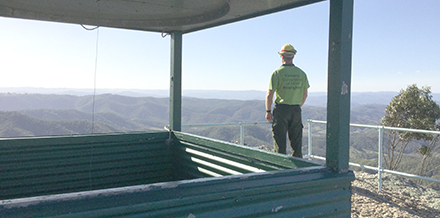Forestry Corporation has released a review of long-term sustainable yield of timber from NSW State forests following the 2019-20 bushfires. The review includes a detailed analysis of fire impacts on each of the forestry regions in NSW and uses satellite-based fire intensity modelling to determine the scale of impacts on the forests and the available timber resource for supply to local industry. Source: Timberbiz
The updated models and assumptions have been independently reviewed by Associate Professor Cris Brack of the Fenner School of Environment and Society at the Australian National University.
Forestry Corporation’s General Manager Hardwood Forests Division, Daniel Tuan, said sustainable yield is modelled over a 100-year timeframe.
“This is to ensure the amount of timber harvested and the stocks of timber in the forests remain stable over the long-term, so that current harvesting does not compromise the availability of wood from forests in the future,” Mr Tuan said.
NSW State forests are a mix of natural forests and timber plantations that are managed to produce a consistent supply of hardwood timber over the long term. Forestry Corporation harvests around one per cent of native State forests each year. Most of the native State forests are regrowth forests, which means the trees seen today have grown to replace trees previously removed for timber.
State forests that are designated for timber production make up 17% of the public forest estate in NSW. The remaining 83% of public forest in NSW is set aside for conservation.
“It takes 30 to 50 years to grow a tree that will produce high quality timber so it’s essential we ensure our forests are managed sustainably to maintain forest health and biodiversity as well as supplying products for local industry,’’ Mr Tuan said.
“Reviewing the sustainable yield models for hardwood forests is complex because it must take into account a range of tree species that respond to fire in different ways.
“The 2019-20 bushfires affected around half of NSW State forests to varying degrees, making the sustainable yield modelling particularly challenging.”
Forestry Corporation commenced the sustainable yield review immediately following the declaration the fires were extinguished in March 2020 and it was completed within 12 months. New satellite-based mapping technologies were used to determine the extent and severity of fire impacts.
“Because of the hazards posed by working in the forest immediately after the fires, it was not safe to carry out field measurements, so the review used existing tree measurement data overlaid with fire severity mapping, scientific data and broad field assessments to model the impacts and recovery of different tree species,’’ Mr Tuan said.
“Normally the models are updated every five years but because of the scale of the fires, we brought this review forward. We will still undertake the scheduled five-year review in 2023-24 as part of the Reginal Forest Agreement.”
On the North Coast, the review found the models are quite positive, showing timber yield will only reduce by around four per cent overall, with larger impacts on some timber producing species.
Mr Tuan said the low figure is due to a combination of factors including the fire resilience of many species in this region.
‘’More than two thirds of the high-quality timber yield in the region is Blackbutt, which was not significantly impacted by the fires, is fire-tolerant and fast growing, and is also widely stocked in our timber plantations” he said.
On the South Coast and Tumbarumba, the models show a more significant impact from the 2019-20 fires. As a result, timber supply in these areas will decrease significantly in these areas.
‘’While all of the affected forests are expected to regenerate and regrow over time, we cannot continue to supply timber at the levels that we had previously been operating due to the loss of mature and growing timber stocks,” Mr Tuan said.
State forests in Eden were also significantly impacted by fire. However, the forests of this region are partially fire tolerant and most fire-affected timber can harvested be at existing levels over the next 10 years. After this time, timber supply will likely reduce while the broader forests regrow.
“We will now begin working with our customers on both the north and south coasts to ensure our commitments align with the sustainable yield of timber from the forests we manage,” Mr Tuan said.
“These updated models will ensure we continue to set responsible and sustainable limits on the annual volume of timber we produce and, combined with the strict rules that protect old growth, rainforest, wildlife habitat and biodiversity, ensure the long-term sustainability of the forests we manage.”
The updated 100-year wood supply models are available at www.forestrycorporation.com.au






